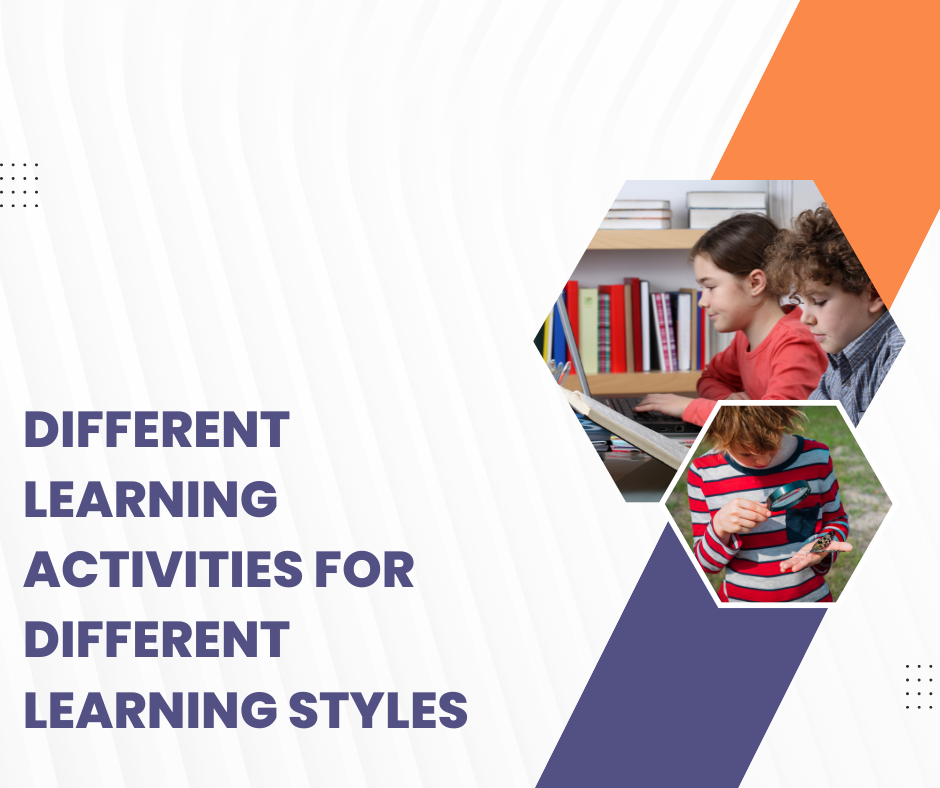Different Learning Activities for Different Learning Styles

Drawing, using graphics or mind maps, rhyming, reading out loud, role-playing... All of these are activities that might be suitable for children with different learning styles.
In this article:
Introduction to learning styles
When I was a student, I could read and read till my brain started to bleed, no use. But when I made mind maps, some pieces of information actually stayed in my head. And when I used colour-coding systems, it was even better. One of my students told me that he sees pictures in his head when he learns new vocabulary. Some of my colleagues learned best when they read something out loud. I had friends at the university who used to play music in the background while learning, while others preferred silence. My kids need a lot of movement and hands-on activities (most children do).
These examples might speak in favour of different learning styles.
There are, however, some researchers [1] who do not support the learning styles concept. They claim that student grade performance (those were anatomy students) has nothing to do with their dominant learning style or with any learning style(s) they scored highly on. As the authors of this study put it - student performance in anatomy was not correlated with their score in any VARK categories.
VARK styles
VARK styles are known as - visual, auditory (aural), reading/writing and kinesthetic. There are many more learning style categories and frameworks, but VARK is among the most popular. Some argue that students will improve their performance if they think about how they learn but not because the material is matched to their supposed learning style.
There is absolutely no doubt that thinking about the way we learn, also called metacognition, influences our learning and performance.
However, if you are open to this idea of different learning styles, here are a few activities you can try out with your kid.
Visual
- Ask your child to describe a picture in their textbook.
- Encourage them to colour-code their notes. You can show them some examples.
- Geography: underline or write the names of capital cities in red, the population in green
- History: highlight all the years in blue, names in yellow
- Help them write to-do lists for school assignments and put them on a pinboard. It helps them see and remember the plan.
- Show them how to make flashcards - write a note or keywords and draw them.
- Suggest learning also from encyclopaedias - these are usually rich in illustrations.
- Help them visualise the information they are learning using phrases, such as "Picture this", "Let's see what you would do."
- Propose drawing a picture or comic about the topic they have to learn. And no, they don't have to be artists to use their drawings as a learning resource.
Auditory (aural)
- Talk to your child about the lesson they have to study. Discuss school things during everyday activities.
- Teach your child how to record themselves while reading a text, and then listen to the recording.
- Help them think of a song or a rhyme to memorise the information from the lesson.
- Suggest reading their notes back to themselves when they get home from school.
Reading and writing
- Suggest making lists.
- Show them how to use dictionaries and glossaries.
- Encourage them to read the hand-outs the teacher gave them.
- Propose copying and re-writing their notes or texts.
- Inspire them to do any "extra" suggested reading.
- Suggest writing summaries of the lessons they learned.
- Help them organise any diagrams, or graphs into statements, e.g. "This graph shows that the trend is…"
Kinesthetic
- Let them study in the living room or some other large space so they can move, write and draw.
- Give them opportunities to apply what they have learned - count money to practise addition, make smoothies to revise fruit vocabulary.
- Work with them on some hands-on activities. Help them learn about motion sensors by building a robot.
- Encourage them to draw diagrams, graphs and maps.
- Have some fun with role-plays.
- Ask them to take the role of a teacher and teach you a new lesson.
You've probably noticed expressions like "encourage them to do something", "work with them", "help them write this or that", and "teach them to use something". Motivating schoolchildren can be easier said than done. However, the examples and suggestions listed here don't support the proposition that parents should become teachers at home. They offer ideas you can use to share your enthusiasm about your kid's learning and lead by example showing that learning never ends. To be involved in your child's learning means expressing interest, giving some examples, sharing ideas, and letting them apply these ideas to their learning.
[1] Husmann, P.R. and O'Loughlin, V.D. (2019), Another Nail in the Coffin for Learning Styles? Disparities among Undergraduate Anatomy Students' Study Strategies, Class Performance, and Reported VARK Learning Styles. American Association of Anatomists, 12: 6-19. https://doi.org/10.1002/ase.1777



